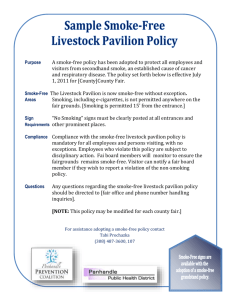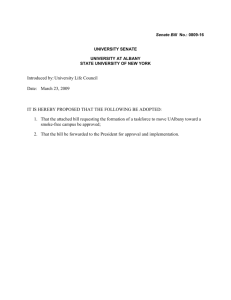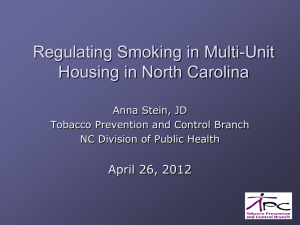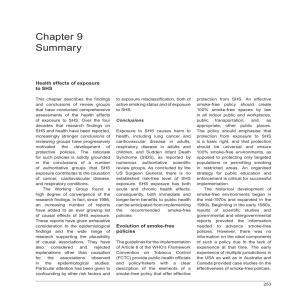TH-3.04 Creating a Smoke Free Campus at UB
advertisement
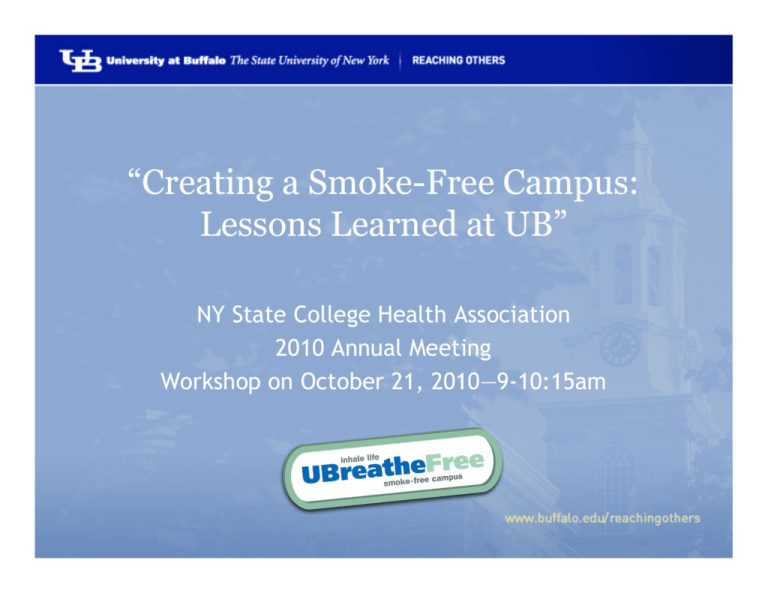
“Creating a Smoke-Free Campus: Lessons Learned at UB” NY State College Health Association 2010 Annual Meeting Workshop on October 21, 2010—9-10:15am Wellness Education Services Student Wellness Team Division of Student Affairs Sherri Darrow, PhD ~ Director Sharlynn Daun-Barnett, LMSW, CPS ~ ATOD Prevention Specialist Our mission is to improve the health of students in the broadest sense Health promotion unit Public Health principles Environmental strategies Student Affairs standards Today’s Presentation • Section #1: Six steps to implementing a smoke-free campus policy • Section #2: Six potential obstacles to implementing a smoke-free campus policy • Section #3: Evaluating the impact of a smoke-free campus policy UBreathe Free Documentary 8:13 minutes Gives background leading up to August 1, 2010, when campus went completely smoke-free Transitional year where people could smoke in parking lots, more than 100 feet from buildings in 2009-2010 http://www.facebook.com/pages/Buffalo-NY/UBreathe-Free-Is-Awesome/298707560371?v=app_2392950137&ref=ts#!/video/video.php?v=423165421139 Section #1 SIX STEPS TO IMPLEMENTING A SMOKE-FREE CAMPUS POLICY Step 1 - Define Policy and Reasons for Adopting a Smoke-Free Policy What is the policy? Is it Smoke-free or Tobacco free? Are there designated smoking areas? Are there boundaries around buildings? To whom does the policy apply? (e.g. vendors) Can people smoke in university vehicles? Can people smoke in their own vehicles? The policy reads: …smoking is prohibited on all University managed property, both indoors and outdoors…including: Buildings Off-site UB locations University-owned vehicles Why are universities adopting tobacco-free policies? Our Talking Points No safe level of secondhand smoke Negative environmental impact Tobacco industry targets teens Regulations are proven deterrents National smoke-free trends in occupational and educational settings Step 2 - Set Timeline for Implementation • Build a committee with stakeholders across campus • Provide years to plan and educate before takes effect • 1st year we allowed smoking in parking lots 100 feet from buildings • Made a priority issue for Division of Student Affairs • Brought policy expert to campus • Administrative buy-in is ongoing process Step 3 - Determine Strategies for Communication of the Policy Important Up Front Strategies • Administrative statement to the campus • Centralized website for policy • Identify a place and person for complaints • Information must reach students, faculty and staff • Admissions and Orientation documents and presentations • Opening Week activities Step 3 - Determine Strategies for Communication of the Policy Ongoing Strategies • Policy cards • Door stickers and signage • Listening and debriefing • Staff and student club meetings • Facebook fan page • Editorials and letters to school newspaper • Direct conversations with those interested Step 4 - Establish Clear Expectations of Compliance This is our current priority To have uniform understanding and buy-in for: What the policy is Why we have the policy What the behavioral expectations are How to enforce with an emphasis on selfenforcement and campus-wide trained ambassadors Step 5 - Create Opportunities for Student Involvement To Educate about the Policy UBreathe Free Tabling Supporter Team Shifts Supporter Workshops Step 5 - Create Opportunities for Student Involvement To Provide Smoking Cessation Services One-on-one Consultation Weekly Quit Clinics Quit Coaching Plan Your Quit Workshops Step 5 - Create Opportunities for Student Involvement • Partner with health sciences such as School of Pharmacy • Utilize student interns (Social Work, Human Services, SAGE Program) • Advertise volunteer opportunity with Career Services • Contact student clubs for community service programming • Contact academic programs with service component Step 6 - Provide Smoking Cessation Services • Human Resources and Student Wellness Office • Offer in preparation for becoming smoke-free • Create multiple means of outreach (consultation, workshops, worksheets) • Advertise widely and link with orientations/trainings • Provide free NRT with consultation • Routinely refer to the NY Smokers’ Quitline Section #2 SIX POTENTIAL OBSTACLES TO IMPLEMENTING A SMOKE-FREE CAMPUS POLICY #1 Focusing Too Much on Smokers • Misperceptions about smokers’ rights • People do not need to quit smoking, they just need to respect the policy • People quitting smoking is a benefit of the policy, but not a key reason to have this policy • Attending a cessation program should not be a penalty for breaking the policy Law Synopsis by the Tobacco Control Legal Consortium entitled “There is No Constitutional Right to Smoke,” by Samantha K. Graff, July 2005. #2 Enforcing a Campus Policy versus a Law Like alcohol policies on our campuses Environmental management Stakeholders across campus Comprehensive and on-going Students, faculty and staff are 3 distinct audiences Union contracts Can’t stay with one department #3 Limited Resources to Implement and Enforce the Policy National, State & SUNY budgetary crunch Understaffing of health promotion, law enforcement and other key departments Competing priorities Safety and emergency issues Capital projects Other Factors on Your Campuses?? #4 Campus Space Managed by Non-Campus Entities The Commons Prime Location CVS Pharmacy Tobacco Sales Restaurants Signage Litter #5 Increase in Cigarette Butt Litter • Butt containers removed • People blame policy for cigarette litter Talking Points: • Reframe to say “smokers are choosing to litter their cigarette butts” • Cigarette butts are the world’s greatest litter problem, 4.3 trillion butts littered each year • Each butt takes 25 years to decompose Host Cigarette Butt Pick-up Events #6 Culture-Change Takes Time Section #3 EVALUATING THE IMPACT OF A SMOKE-FREE CAMPUS POLICY #1 Changes in Knowledge about the Smoke-Free Policy 80% of freshmen reported knowledge On-line alcohol education survey One month after orientation MyUB on-line weekly campus surveys 2008 and will repeat in 2011 Know it exists but not exactly what it is or why! #2 Changes in Attitudes Regarding the Smoke-Free Policy UB Freshmen Survey – summer 2009 (n= 2850) 70% or more said these campus tobacco issues were important to them: No safe levels of 2nd hand smoke (77%) Tobacco industry targets teens (72%) Environmental impact (71%) Policies can help people quit or not start (72%) #3 Changes in Smoking Behaviors UB data: National College Health Assessment Never smoked Yes, not in 30 days Current Smoker 2007 (n=2001) NCHA-I 67% 18% 15% 2010 (n=5,237) NCHA-II 72% 16% 12% 88% of current UB students are nonsmokers compared with 85% nationally Healthy Campus 2010 goals is to reduce smoking by college students <10.5% #4 Changes in Smoking Behaviors UB Freshmen Survey –2009 (n= 2850) 89% 82% 84% 86% no tobacco in last month of smokers said they were interested in quitting lived in smoke-free homes drive in smoke-free vehicles #5 Recorded Observations of Environmental Change • Environmental Stewardship Committee created in November 2007 to lead President Simpson’s endorsement of American College and University Presidents Climate Commitment • Environmental partners on campus • UBreathe Free Volunteer Supporter Teams -Determine problem areas through nosmoke@buffalo.edu -Use a log to chart observed smokers and littered cigarette butts #6 Collaborative Partnerships and Student Involvement • UBreathe Free Committee • Collaboration with Wellness and Work/Life Balance, Colleges Against Cancer and Student Association • Number of students trained 360 School of Pharmacy students 180 Resident Assistants and Community Assistants 13 Wellness Education Services interns/volunteers 60 student Supporter volunteers • Number of students who volunteer 93 pharmacy students--12 regular Supporter volunteers Questions? Wellness Education Services Division of Student Affairs Sherri L. Darrow, darrow@buffalo.edu, 716-645-6936 Sharlynn Daun-Barnett, sd62@buffalo.edu, 716-6456939
